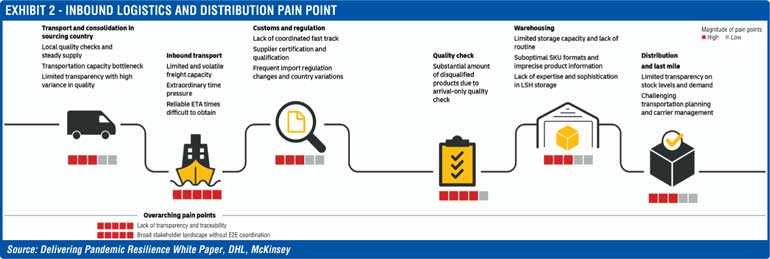Thursday Nov 27, 2025
Thursday Nov 27, 2025
Monday, 12 October 2020 00:00 - - {{hitsCtrl.values.hits}}


With first emergency use authorisations for COVID-19 vaccines expected to be effective in the last quarter of 2020, logistics providers are challenged to rapidly establish medical supply chains to deliver more than 10 billion doses worldwide. DHL, working with McKinsey & Company as analytics partner, has published a white paper on securing a stable supply chain for vaccines and medical goods during COVID-19, and future health crises.
Currently, more than 250 vaccines across seven platforms are being developed and trialled. As COVID-19 vaccines have leapfrogged development phases, stringent temperature requirements (up to -80°C) are likely to be imposed for certain vaccines to ensure that their efficacy is maintained during transportation and warehousing. This poses novel logistics challenges to the existing medical supply chain that conventionally distributes vaccines at ~2-8°C.
In the paper, DHL evaluates how the transport of vaccines as a highly temperature-sensitive product can be managed effectively to combat the further spread of the virus. The scope of this task is immense: To provide global coverage of COVID-19 vaccines, up to ~200,000 pallet shipments and ~15 million deliveries in cooling boxes as well as ~15,000 flights will be required across the various supply chain set-ups.
“The COVID-19 crisis emerged with an unprecedented breadth and impact. It required governments, businesses, and the logistics industry alike to adapt quickly to new challenges. As a world leader in logistics, we want to share our experience of operating during one of the biggest health crises in recent history, in order to develop strategies in an ever-more connected world,” explains DHL Chief Commercial Officer Katja Busch. “To protect lives against the pandemic, governments have moved towards a more active role in medical supply chains. Over the past few months, we have demonstrated that sufficient planning and appropriate partnerships within the supply chain can play a key role as governments work to secure critical medical supplies during health emergencies such as this.”
Future public health crisis management to include public-private partnerships
Since the outbreak of the pandemic, demand for medical supplies has surged. For example, UNICEF sourced 100 times more face masks and 2,000 times more medical gloves than in 2019. Bringing medical supplies from their distant sources to the frontline has been one of the most crucial activities in pandemic response management in the first phase of the health emergency. For PPE specifically, inbound logistics were a major challenge due to geographically concentrated production, limited airfreight capacity and a lack of inbound quality checks. To ensure stable medical supply in a future health crisis, a comprehensive setup of public health crisis strategies and structures needs to be established by governments with partnerships from both public and private sectors.
“From the onset, Asia was in the cockpit of the supply race with millions of PPE and test kits shipped out of China and South Korea respectively,” added Leonora Lim, Head of Life Science and Healthcare, DHL Customer Solutions and Innovation, Asia Pacific. “The delivery of vaccines would be a completely different ball game however given the scale of distribution and strict temperature requirements. A close partnership between the public and private sectors would address the urgent need for a viable medical supply chain that will preserve the integrity of these vaccines and have them delivered to over 200 countries and territories in a timely fashion.”
To kick-start the dialogue among the different actors and improve pandemic resilience in medical supply logistics, DHL provides a framework for the cooperation of logistics companies with authorities, politicians, NGOs as well as the life sciences industry. The framework helps to establish measures to ensure the most stable and safe supply chains possible. Besides an emergency response plan, this includes a partnership network, strong physical logistics infrastructure and IT-enabled supply chain transparency. Lastly, a response unit with a clear mandate should be put in place to implement all critical activities at short notice.
To read the complete white paper, please click on the following link: www.dhl.com/pandemic-resilience.